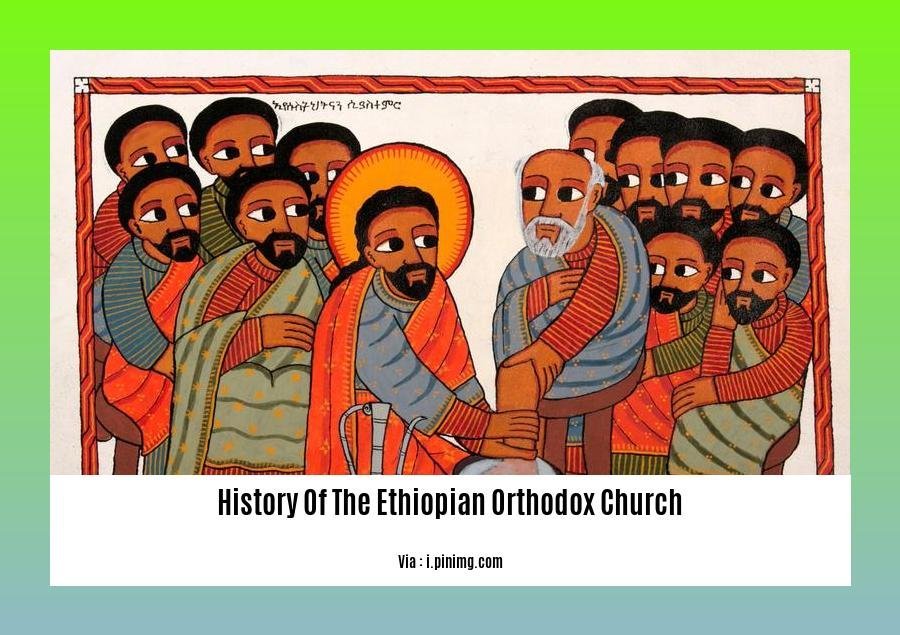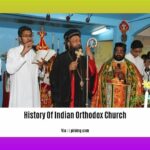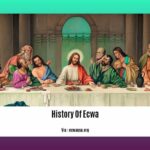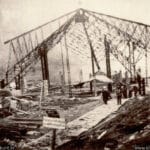Immerse yourself in the profound history of the Ethiopian Orthodox Church, a spiritual sanctuary that has stood the test of time for over two millennia. From its ancient roots in the era of Aksum to its current position as a bastion of faith, this article takes you on an extraordinary journey through the annals of one of the world’s oldest and most influential Christian communities – the Ethiopian Orthodox Church. Prepare to be enthralled as we delve into the depths of its rich traditions, unwavering devotion, and the profound impact it has had on shaping the cultural and spiritual tapestry of Ethiopia. Embark on this voyage of faith and discover the enduring legacy of the Ethiopian Orthodox Church.
Key Takeaways:
- Founded in the 4th century, the Ethiopian Orthodox Church proudly stands as one of the few original Christian churches in sub-Saharan Africa.
- The church’s origins trace back to the Kingdom of Aksum’s embrace of Christianity in the year 330.
- With a significant following, the Ethiopian Orthodox Church counts between 36 million and 49.8 million devoted adherents in Ethiopia.
- The church upholds its independence as an autonomous Christian patriarchate.
- Its founding is attributed to the efforts of Saint Frumentius and his brother Aedesius.
History of the Ethiopian Orthodox Church
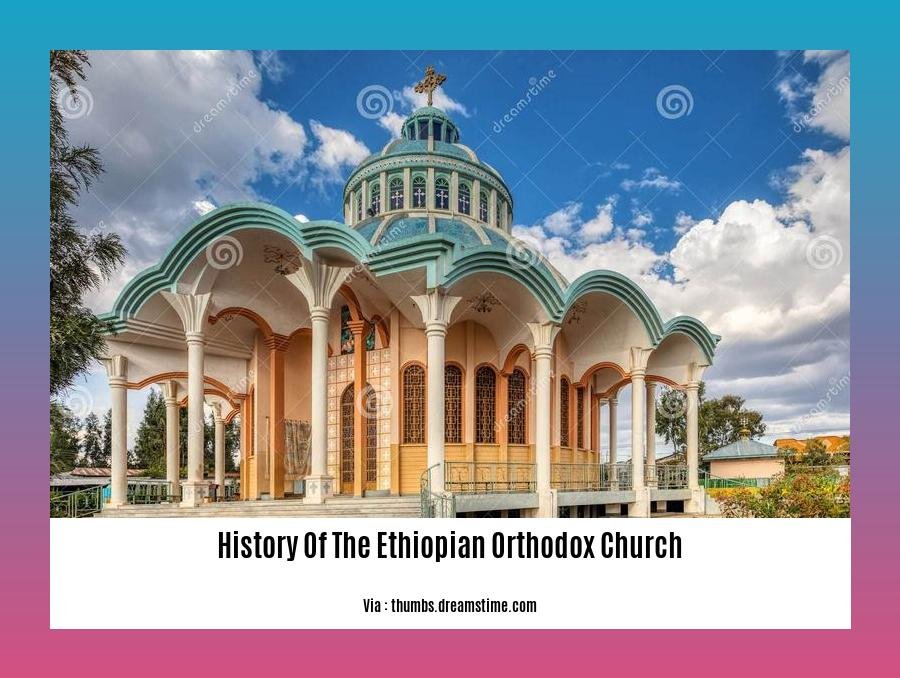
The history of the Ethiopian Orthodox Church is a testament to the unique evolution of Christianity in Africa. Emerging as one of the world’s most ancient Christian communities, its roots stretch back to the 4th century, a period marked by the influence of Saint Frumentius and his brother Aedesius, who are credited with introducing Christianity to the Kingdom of Aksum.
Pillars of the Ethiopian Orthodox Church
Ancient Origins: Tracing its lineage back to the 4th century, the Ethiopian Orthodox Church boasts a rich legacy as one of the earliest Christian communities in sub-Saharan Africa.
Monastic Tradition: The church’s monastic tradition holds great significance, with monasteries serving as centers of spirituality, learning, and community cohesion. The oldest of these monasteries, Debre Damo, dates back to the 6th century and continues to inspire awe and reverence among believers.
Unique Liturgy: The Ethiopian Orthodox Church follows a distinctive liturgy known as the Ge’ez Rite, which is conducted in the ancient Ge’ez language. This liturgy, characterized by its intricate symbolism and rich melodies, offers a profound spiritual experience for its adherents.
Biblical Canon: The church’s canon of scripture includes 81 books, surpassing the traditional 66 books found in other Christian denominations. This expanded canon reflects the church’s deep reverence for the written word and its commitment to preserving ancient traditions.
Cultural Significance: The Ethiopian Orthodox Church is deeply intertwined with the cultural fabric of Ethiopia, shaping societal norms, values, and artistic expressions. Its festivals, rituals, and ceremonies are vibrant displays of the church’s enduring influence on Ethiopian culture.
Navigating Sacred Texts
The Bible: The foundation of the Ethiopian Orthodox Church’s beliefs lies in the Bible, which holds a position of supreme authority in matters of faith and practice.
Ge’ez Manuscripts: The church’s vast collection of ancient Ge’ez manuscripts, including the Kebra Nagast, provides invaluable insights into its history, theology, and traditions. These manuscripts are meticulously preserved and studied by scholars and theologians.
Synodal Decisions: The church’s governing body, known as the Holy Synod, issues synodal decisions that guide the church’s practices and teachings. These decisions are based on scriptural principles and the church’s rich tradition.
Encounters with Islam
Peaceful Coexistence: The Ethiopian Orthodox Church has historically maintained a peaceful coexistence with Islam, despite periods of political tension and conflict. This coexistence is rooted in mutual respect and a shared commitment to religious freedom.
Mutual Influence: The proximity to Islamic communities has led to cultural exchange and mutual influence. The church’s architecture, music, and certain practices bear the marks of Islamic influences, reflecting the rich tapestry of Ethiopia’s religious heritage.
Challenges and Resilience
Political Turmoil: The Ethiopian Orthodox Church has endured periods of political turmoil and persecution, including the Derg regime’s repressive policies. Despite these challenges, the church’s resilience and steadfastness have allowed it to emerge stronger and more committed to its mission.
Preserving Traditions: In the face of globalization and modernization, the church faces the challenge of preserving its ancient traditions while adapting to a changing world. Striking a balance between tradition and modernity is crucial for the church’s continued relevance and vitality.
Ecumenical Relationships: The Ethiopian Orthodox Church actively participates in ecumenical dialogues and initiatives with other Christian denominations, seeking common ground and fostering understanding among different faith communities.
Conclusion
The history of the Ethiopian Orthodox Church is a chronicle of faith, resilience, and cultural significance. As one of the world’s oldest Christian communities, it has played a pivotal role in shaping the religious landscape of Ethiopia and beyond. Its ancient traditions, unique liturgy, and commitment to scripture continue to inspire and guide millions of believers, making it a living testament to the enduring power of faith.
Looking to discover the rich history of soccer in Mexico? Dive into the fascinating tale of how the sport became a national obsession by clicking here: history of soccer in mexico.
Explore the captivating history of Surigao del Norte, from its humble beginnings to its transformation into a bustling province. Uncover its unique cultural heritage and resilience in the face of adversity: history of surigao del norte.
The influence of the Aksumite Empire on the church
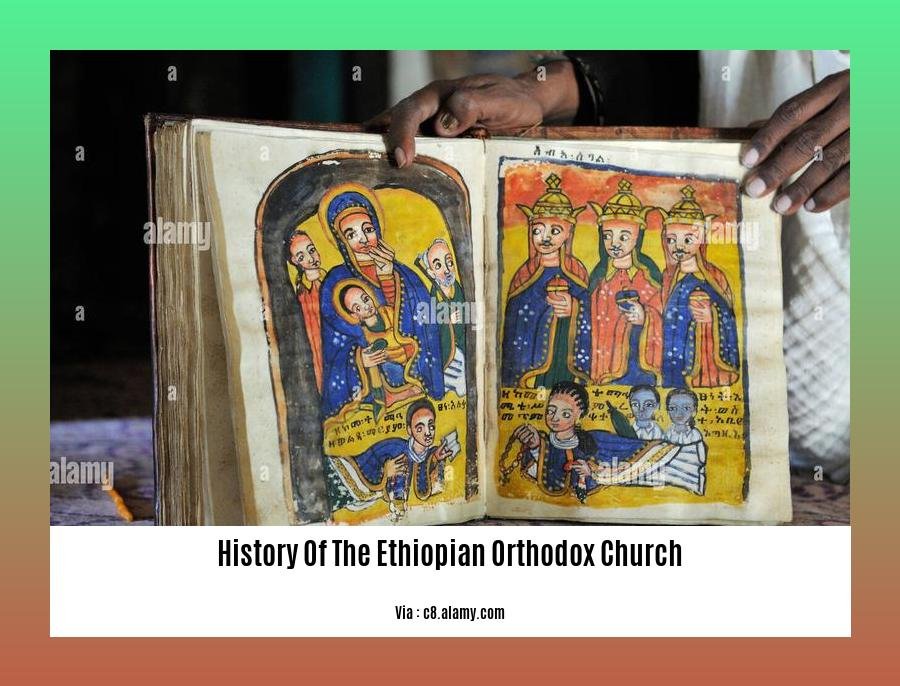
The Aksumite Empire’s influence on the Ethiopian Orthodox Church was profound and multifaceted, shaping its early development, religious identity, and cultural significance. This illustrious empire’s patronage of Christianity and promotion of the faith within its realm had a lasting impact on the church’s growth and evolution. Let’s delve into this rich history and explore how this ancient empire left an enduring mark on the Ethiopian Orthodox Church:
Key Takeaways:
- Royal Embrace: The adoption of Christianity by King Ezana in the 4th century marked a pivotal moment, transforming the Aksumite Empire into a Christian kingdom and granting the church official recognition and support.
- Aksumite Patronage: The empire’s rulers generously supported the construction of churches and monasteries, including the iconic Church of Our Lady Mary of Zion in Aksum, further solidifying the church’s presence and influence.
- Spread of Monasticism: The Aksumite Empire embraced monasticism as a vital aspect of religious life, establishing numerous monasteries that became centers of spiritual growth, learning, and community cohesion.
- Cultural Exchange: The empire’s extensive trade networks facilitated cultural exchange between the Aksumites and other Christian communities in the Mediterranean world, influencing the church’s liturgical practices, art, and architecture.
- Enduring Legacy: The Aksumite Empire’s patronage and promotion of Christianity laid the foundation for the Ethiopian Orthodox Church’s enduring strength and resilience, contributing to its position as one of the oldest and most influential Christian communities in Africa.
Weaving the Tapestry of Faith:
The Aksumite Empire, with its embrace of Christianity, became a beacon of faith in the region. The empire’s rulers, recognizing the transformative power of religion, actively supported the church’s growth and development. Their patronage extended beyond mere financial support, as they actively engaged in promoting Christian values and practices throughout their realm.
A Legacy Etched in Stone:
The Aksumite Empire’s influence on the Ethiopian Orthodox Church is not merely a matter of historical record but is also evident in the tangible legacy left behind. The empire’s patronage of church construction resulted in the erection of magnificent structures that still stand today, serving as testaments to the deep faith and architectural prowess of the Aksumite era. Churches like the Church of Our Lady Mary of Zion in Aksum and the rock-hewn churches of Lalibela bear witness to the enduring impact of the Aksumite Empire on the Ethiopian Orthodox Church.
Nurturing the Seeds of Monasticism:
Monasticism, a vital aspect of the Ethiopian Orthodox Church, found fertile ground in the Aksumite Empire. The empire’s rulers recognized the importance of monastic communities as centers of spiritual growth and learning. They supported the establishment of numerous monasteries throughout their realm, providing land, resources, and protection. These monasteries became havens of contemplation, scholarship, and community service, attracting individuals seeking a deeper connection with God and a life of devotion.
A Tapestry of Cultural Exchange:
The Aksumite Empire’s extensive trade networks, spanning the Red Sea and reaching as far as the Mediterranean, fostered cultural exchange between the Aksumites and other Christian communities. This vibrant exchange enriched the Ethiopian Orthodox Church’s liturgical practices, art, and architecture. Influences from Egypt, Syria, and the Byzantine Empire blended with local traditions, creating a unique and diverse religious tapestry.
A Legacy That Endures:
The Aksumite Empire’s patronage and promotion of Christianity laid a solid foundation for the Ethiopian Orthodox Church’s enduring strength and resilience. The empire’s support helped the church weather political turmoil, persecution, and societal change, emerging as a steadfast beacon of faith and a central pillar of Ethiopian culture and identity. Today, the Ethiopian Orthodox Church stands as one of the oldest and most influential Christian communities in Africa, a testament to the enduring legacy of the Aksumite Empire’s patronage.
Citations:
- Smithsonian Magazine: Church Unearthed in Ethiopia Rewrites the History of Christianity
- The Metropolitan Museum of Art: Christianity in Ethiopia
The role of the Ethiopian Orthodox Church in Ethiopian society and culture
In a land steeped in ancient traditions and rich cultural heritage, the Ethiopian Orthodox Church stands as a beacon of faith and a cornerstone of Ethiopian society, deeply entwined with the fabric of the nation. Its legacy can be traced back to the 4th century when Christianity was first introduced to the Kingdom of Aksum and was officially adopted as the state religion in the 6th century.
Over the centuries, the Ethiopian Orthodox Church has played a pivotal role in shaping and influencing various aspects of Ethiopian life, from religious practices and societal norms to art, architecture, and literature.
Preserver of Traditions
The Ethiopian Orthodox Church has served as the custodian of Ethiopia’s rich cultural heritage and ancient traditions. It has played a crucial role in preserving and transmitting knowledge and practices that span generations, including ancient liturgical texts, traditional rituals, and sacred art forms.
Community Cohesion
The church has been an integral part of community life, fostering a sense of unity and togetherness among its members. Religious festivals, such as Timkat (Ethiopian Epiphany), bring communities together in joyous celebrations, reinforcing the bonds that hold society together.
Cultural Expression
The church’s influence is evident in Ethiopia’s vibrant artistic expressions. From the intricate paintings adorning church walls to the soulful melodies of traditional hymns, the church has inspired artistic masterpieces that reflect the nation’s deep religious devotion.
Educational and Social Welfare
The church has historically been a provider of education and social welfare services, establishing schools and hospitals to serve the community’s needs. This commitment to education and social responsibility has had a profound impact on the development of Ethiopia’s human capital.
Political and Historical Influence
The Ethiopian Orthodox Church has played a significant role in Ethiopian politics and history, serving as an advisor to rulers and influencing state affairs. Throughout history, the church has been a source of stability and moral guidance, even during times of political turmoil.
Key Takeaways:
- The Ethiopian Orthodox Church is one of the oldest Christian communities in sub-Saharan Africa, with a rich history and tradition.
- It has been a custodian of Ethiopia’s cultural heritage, preserving ancient practices and traditions.
- The church has played a vital role in fostering community cohesion, strengthening the bonds that hold Ethiopian society together.
- Its influence is evident in Ethiopia’s artistic expressions, inspiring masterpieces that reflect the nation’s deep religious devotion.
- The church has historically provided education and social welfare services, contributing to the development of Ethiopia’s human capital.
- It has been a significant player in Ethiopian politics and history, serving as an advisor to rulers and influencing state affairs.
Citation
- The Ethiopian Orthodox Tewahedo Church
- The Ethiopian Orthodox Church: Its History, Beliefs, and Practices
The current status and challenges facing the Ethiopian Orthodox Church
The Ethiopian Orthodox Tewahdo Church, one of the world’s oldest and largest Christian communities, epitomizes a blend of rich history and pressing challenges. Founded in the 4th century, the church boasts a vibrant monastic tradition, a unique Ge’ez Rite liturgy, and a rich canon of 81 books. Deeply intertwined with Ethiopian culture, the church faces an array of challenges as it strives to maintain its relevance and influence in a changing world.
Key Challenges
The Ethiopian Orthodox Church grapples with several challenges that threaten its stability and growth.
Internal Conflicts: The church has been marred by internal conflicts and schisms, largely driven by political and ethnic allegiances. These disputes have weakened the church’s unity and hindered its ability to effectively address external challenges.
Competition from Evangelical Churches: The rise of Evangelical churches, often funded by external sources, has diverted significant numbers of followers from the Ethiopian Orthodox Church. Evangelical churches often offer a more modern and accessible approach to Christianity, attracting younger generations seeking a more personal and emotional religious experience.
Revival of Traditional Practices: The revival of traditional practices and beliefs, such as the veneration of saints and spirits, poses a challenge to the Ethiopian Orthodox Church’s authority and teachings. This resurgence of traditional practices reflects a desire among some Ethiopians to reconnect with their cultural roots and challenge the dominant influence of the church.
Political Influence: The Ethiopian Orthodox Church has historically been closely intertwined with the Ethiopian government, often serving as a tool for political control and legitimacy. This close relationship has led to accusations of corruption and political interference, eroding the church’s credibility and moral authority.
Church’s Response to Challenges
In response to these challenges, the Ethiopian Orthodox Church has undertaken several initiatives and reforms.
Internal Dialogue: The church has initiated internal dialogues and reconciliation efforts to address conflicts and schisms, aiming to bridge divisions and restore unity.
Ecumenical Engagements: The church has increased its participation in ecumenical dialogues with other Christian denominations, fostering understanding and cooperation.
Modernization Efforts: In an effort to attract younger generations, the church has made efforts to modernize its approach, including the use of modern technology and the introduction of contemporary music and worship styles.
Preserving Traditions: The church remains committed to preserving its ancient traditions and practices while adapting to a changing world. It emphasizes the importance of preserving its unique liturgy, language, and rituals that set it apart from other Christian denominations.
Key Takeaways:
The Ethiopian Orthodox Church is a prominent Christian community facing challenges in maintaining its unity and relevance in a changing world.
Internal conflicts, competition from Evangelical churches, revival of traditional practices, and political influence are key challenges affecting the church.
The church is responding through internal dialogues, ecumenical engagements, modernization efforts, and the preservation of traditions.
FAQ
Q1: When was the Ethiopian Orthodox Church founded?
A1: The Ethiopian Orthodox Church is believed to have been founded in the 4th century by Saint Frumentius and his brother Aedesius during the reign of Ezana, the first Aksumite ruler who adopted Christianity as the state religion.
Q2: What is the significance of the recently discovered ancient church in Ethiopia?
A2: The discovery of the ancient church 30 miles northeast of Aksum, which predates the previously known oldest church in Ethiopia by 100 years, challenges traditional assumptions about the spread of Christianity in Africa and suggests that the Aksumite kingdom was a pivotal center for the early development of the religion.
Q3: What are some unique aspects of the Ethiopian Orthodox Church’s beliefs and practices?
A3: The EOTC places a heavier emphasis on Old Testament teachings than other branches of Christianity and adheres to certain practices found in Orthodox or Conservative Judaism, highlighting the church’s distinct theological and cultural heritage.
Q4: How has the Ethiopian Orthodox Church influenced Ethiopian history and culture?
A4: The EOTC has played a significant role in shaping Ethiopian history and culture, serving as the storehouse of national culture and exerting a profound influence on Ethiopian literature, art, and social life, contributing to the country’s unique identity.
Q5: What are some current challenges facing the Ethiopian Orthodox Church?
A5: The EOTC faces several challenges, including competition from Evangelical churches, the emergence of charismatic figures, and the revival of traditional practices, which have led to internal divisions and schisms within the church, as well as the need to adapt to changing social and cultural dynamics in Ethiopia.
- Crypto Quotes’ Red Flags: Avoid Costly Mistakes - June 30, 2025
- Unlock Inspirational Crypto Quotes: Future Predictions - June 30, 2025
- Famous Bitcoin Quotes: A Deep Dive into Crypto’s History - June 30, 2025
